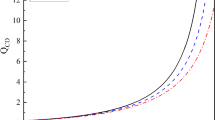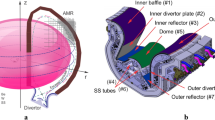Abstract
The International Thermonuclear Experimental Reactor (ITER) tokamak can generate fusion energy in an acceptable method. In this study, the particle and energy equations were developed for \({\text{T}}\left( {{\text{D}},n} \right){}^{4}{\text{He}}\), \({\text{D}}\left( {{\text{D}},n} \right){}^{3}{\text{He}}\), \({\text{D}}\left( {{\text{D}},p} \right){\text{T}}\), and \({}^{3}{\text{He}}\left( {{\text{D}},p} \right){}^{4}{\text{He}}\) fusion reactions and optimum conditions were determined to achieve the maximum gain using differing mixtures of fuel. Also, the particle and energy equations were solved using the zero-dimensional model, and the ITER90H-P plasma parameters were calculated by the numerical methods. The possibility regarding the presence of impurities was ignored in all our calculations.






Similar content being viewed by others
References
B Vincent, N Hudon, L Lefèvre and D Dochain IFAC PapersOnLine 50 13038 (2017)
B Vincent, N Hudon, L Lefèvre and D Dochain IFAC PapersOnLine 49 93 (2016)
A Pajares and E Schuster IEEE Conference on Control Applications (CCA) p 617 (2016)
A E Costley, J Hugill and P F Buxton Nucl. Fusion 55 033001 (2015)
O Motojima Nucl. Fusion 55 104023 (2015)
W Hui, B A Bamieh and G H Miley Fusion Technol. 25 318 (1994)
B G Hong, D W Lee and S R In Nucl. Eng. Technol. 40 87 (2008)
H Zohm Philos. Trans. R. Soc. A 377 20170437 (2019)
C Powell and O J Hahn Nucl. Fusion 12 667 (1972)
J P Ongena and G V Oost Fusion Sci. Technol. 61 3 (2012)
T Tanabe Tritium: Fuel of Fusion Reactors p 27 (2017)
S M Motevalli and F Fadaei Int. J. Modern Phys. E 21 1250078 (2012)
S M Motevalli, T Mohsenpour and N Dashtban Eur. Phys. J. Plus 131 330 (2016)
J P Freidberg Plasma Physics and Fusion Energy (New York: Cambridge University Press) (2008)
W M Stacey Jr Nucl. Fusion 13 843 (1973)
S Garcia and J J Martinell Fusion Eng. Des. 147 111227 (2019)
J J Martinell Radiat. Eff. Defects Solids 166 821 (2011)
E Bertolini, F Engelmann, M A Hoffman and A Taroni Nucl. Fusion 17 955 (1977)
M D Boyer and E Schuster IEEE International Conference on Control Applications (CCA) p 246 (2011)
L M Hively Nucl. Fusion 17 873 (1977)
E Schuster, M Krstić and G Tynan Fusion Sci. Technol. 43 18 (2003)
J E Vitela and J J Martinell Plasma Phys. Control. Fusion 40 295 (1998)
R J Hawryluk et al. Nucl. Fusion 55 053001 (2015)
J E Menard Philos. Trans. R. Soc. A 377 20170440 (2019)
S P Hirshman and D J Sigmar Nucl. Fusion 21 1079 (1981)
A Pajares and E Schuster Fusion Eng. Des. 123 607 (2017)
M Jakobs, N L Cardozo and R Jaspers Nucl. Fusion 54 122005 (2014)
M D Boyer and E Schuster American Control Conference (ACC) 5043 (2012)
N A Uckan 15th IEEE/NPSS Symposium. Fusion Engineering 1 183 (1993)
N A Uckan et al. Fusion Technol. 26 327 (1994)
E Schuster, M Krstić and G Tynan Fusion Eng. Des. 63 569 (2002)
M D Boyer and E Schuster American Control Conference (ACC) 1207 (2013)
S M Motevalli, N Dashtban, F Fadaei and F Asadi Bulg. J. Phys. 41 209 (2014)
M D Boyer and E Schuster Plasma Phys. Control. Fusion 56 104004 (2014)
R A Gabrielli, et al. 29th International Symposium on Space Technology and Science, Paper. (2013)
Author information
Authors and Affiliations
Corresponding author
Additional information
Publisher's Note
Springer Nature remains neutral with regard to jurisdictional claims in published maps and institutional affiliations.
Rights and permissions
About this article
Cite this article
Motevalli, S.M., Dashtban, N. & Maleki, M. Determination of optimum conditions in ITER tokamak by using zero-dimensional model. Indian J Phys 95, 2211–2215 (2021). https://doi.org/10.1007/s12648-020-01857-6
Received:
Accepted:
Published:
Issue Date:
DOI: https://doi.org/10.1007/s12648-020-01857-6




